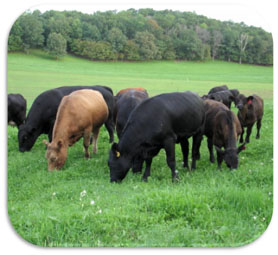Principles of Managed Grazing
 Principles of Managed Grazing
Principles of Managed Grazing
“Let the grass work…” – Walt Whitman
I. Agriculture is not separate from the environment. The term “agriculture” represents diverse and evolving traditions, practices, relationships and knowledge by which humans interact with the environment in order to provide food, fiber and fuel for our communities. All agriculture depends upon and has a significant impact on living ecosystems.
II. During the past fifty years, conventional agriculture has been transformed into an industry that is focused almost exclusively on maximizing yields and increasing profits. To this end, chemical, biological and mechanical technologies have been developed and promoted with the promise of providing total control over natural processes and extricating agriculture from the environment. Wide spread adoption of these technologies, along with increased consolidation and expansion of production and distribution systems, has had devastating consequences for farmers, consumers, economies, communities, animals and ecosystems.
III. The current trends in conventional agriculture are not sustainable. In order to survive, we must recover, create, establish and support alternative agricultural traditions practices, relationships and knowledge that reconnect human communities with living ecosystems.
IV. Managed Grazing is a farming method that recognizes and nurtures the interdependence between agriculture and the environment. In managed grazing systems, livestock are rotated through paddocks of high quality grasses and legumes that are then allowed to rest and re-grow. Managed grazing works with natural relationships and biological processes to improve overall farm health and build productive capacity (rather than focusing on short-term gains and extractive methods). Well-managed grazing farms:
- maintain healthy and productive livestock
- produce high-quality nutritious food
- reduce chemical and fossil fuel use
- improve soil, water and biodiversity resources
- preserve wildlife habitat
- secure a livelihood for farmers and their families
- contribute to local economies
V. Managed grazing is an economically viable and earth friendly method that can be utilized by new as well as established farmers, implemented for any livestock species and adapted for any ecosystem that grows grass. As such, this method should be central to a sustainable agriculture movement that values the environment and biodiversity, animal welfare, public health and nutrition, local food systems, social justice and the viability of rural economies and communities.
VI. As sustainable farmers, we work with the grass because it flourishes almost effortlessly, capturing and transforming sunlight. Grass is an endless gift, which heals the land and sustains the animals that feed us.
